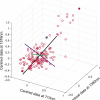Articles and Columns
Lutz Hartiga and Kristin von Czapiewskib
aEurofins, Wiertz-Eggert-Jörissen GmbH, Stenzelring 14b, 21107 Hamburg, Germany
bApplied Biosystems, Applera Deutschland GmbH, Franfurter Straße 129 B, 64293 Darmstadt, Germany
Anton Amann,a,d Alex Schmid,a,b Sabine Scholl-Bürgi,c Stefan Telserb and Hartmann Hinterhuberb
aDepartment of Anesthesia and General Intensive Care, Innsbruck Medical University, A-6020 Innsbruck, Austria
bDepartment of Psychiatry, Sleep Laboratory, Innsbruck Medical University, A-6020 Innsbruck, Austria
cClinical Department of General Paediatrics, Innsbruck Medical University, A-6020 Innsbruck, Austria
Tim S. Brewer and Peter K. Harvey
Department of Geology, University of Leicester, Leicester, LE1 7RH, UK. E-mail: tsb5@le.ac.uk
Cliff Marshall
ESSLAB Limited, Crucible House, Endway, Hadleigh, Essex, SS7 2AN, UK. E-mail: cliff@esslab.com
Tony Davies
External Professor, University of Glamorgan, UK
c/o Waters Informatics, Europaallee 27–29, 50226 Frechen, Germany
Carla Bittencourt, Marcella P. Felicissimo, Jean-Jacques Pireaux and Laurent Houssiau
Laboratoire Interdisciplinaire de Spectroscopie Electronique (LISE), Facultés Universitaires Notre-Dame de la Paix, University of Namur, 61 rue de Bruxelles, B-5000 Namur, Belgium
Heidi Goenaga-Infante and Mike Sargent
LGC Limited, Queens Road, Teddington, Middlesex TW11 OLY, UK. E-mail: ms@lgc.co.uk
A.M.C. Davies
Norwich Near Infrared Consultancy, 75 Intwood Road, Cringleford, Norwich NR4 6AA, UK
Introduction
In my last column I began a revision of basic chemometrics.1 In this column I will discuss some interpretation of the results produced by principal component analysis (PCA) as part two of this revision programme.
Erwin Hoffmanna and Christian Lüdkeb
aGOS - Gesellschaft zur Förderung angewandter Optik, Optoelektronik, Quantenelektronik und Spektroskopie eV, Rudower Chaussee 29, 12489 Berlin, Germany. E-mail: hoffmann@ansci.de
bISAS–Institute for Analytical Sciences, Department Berlin, Albert-Einstein-Str. 9, 12489 Berlin, Germany
Gerhard Litscher
Biomedical Engineering and Research in Anesthesia and Intensive Care Medicine, Medical University of Graz, Auenbruggerplatz 36, A-8036 Graz, Austria. E-mail: gerhard.litscher@meduni-graz.at; http://litscher.at; http://litscher.info
Frank Rutten,* Julian Hendersona and David Briggs
School of Pharmacy and Centre for Surface Chemical Analysis,
aDepartment of Archaeology, School of Humanities, University of Nottingham, University Park, Nottingham NG7 2RD, UK
*Correspondence to: Frank Rutten, School of Pharmacy, University of Nottingham University Park, Nottingham NG7 2RD, UK. E-mail: frank.rutten@nottingham.ac.uk
Tony Davies
External Professor, University of Glamorgan, UK, c/o Waters Informatics, Europaallee 27–29, 50226 Frechen, Germany
Mikael Kubista, Jahan Ghasemi, Björn Sjögreen and Amin Forootan
MultiD Analyses AB, Göteborg, Sweden. E-mail: info@multid.se
PCA is a mathematical method of reorganising information in a data set of samples. It can be used when the set contains information from only a few variables but it becomes more useful when there are large numbers of variables, as in spectroscopic data.
Antonella Rossi,a,b Bernhard Elsenera and Nicholas D. SpencerbaDepartment of Inorganic and Analytical Chemistry, University of Cagliari, Campus of Monserrato, 09100 Cagliari, Italy
I asked the European RM producer if they thought an improvement was needed in the level of awareness about the proper use of reference materials in analytical laboratories. I asked the basic questions I’d asked RM users two years ago.
Peter J. Jenks
the Jenks Partnership, Newhaven House, Junction Road, Alderbury, Salisbury, Wiltshire SP5 3AZ, UK. E-mail: editor@rmreport.com
Peter Lampena and Tony Daviesb
aISAS, Institute for Analytical Sciences, Bunsen-Kirchhoff-Str.11, 44139 Dortmund, Germany
bExternal Professor, University of Glamorgan, UK. c/o Waters Informatics, Europaallee 27–29, 50226 Frechen, Germany
Philip Martina,c and Robert Holdsworthb
aDepartment of Chemical Engineering, UMIST, PO Box 88, Manchester M60 1QD, UK. E-mail: p.a.martin@umist.ac.uk
bTDL Sensors Ltd, UVL, 70–72 Sackville Street, Manchester, UK. E-mail: r.holdsworth@tdlsensors.co.uk
cFrom 1 October 2004, School of Chemical Engineering and Analytical Science, University of Manchester



